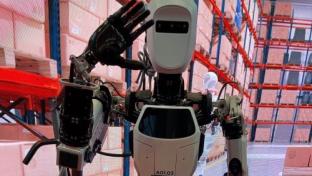EXCLUSIVE: Fabric’s New Co-CEO Gets Down to Business
Just 30 days into the job, Curt Avallone, the newly minted co-CEO of automated e-commerce solution provider Fabric, connected with Progressive Grocer to discuss what retailers can expect in terms of product selection, delivery windows and costs as the company expands in the United States under his expert guidance.
Progressive Grocer: Please provide a brief description of your career and how you came to join Fabric.
Curt Avallone: I’ve been rank-and-file grocery for almost 30 years. During that time, I led not just stores, but also innovation, at H-E-B, and I launched half a dozen new divisions that are multibillion-dollar businesses, everything from e-commerce to restaurants to a fueling station. I’ve had a lot of fun over the last 30 years and had planned on retiring, but I had one last model, automated e-grocery, that had eluded myself and many teams for many years, and ended up being one of the founders of Takeoff Technologies – myself, José [Aguerrevere] and Max [Pedró].
I got the opportunity from the investors at Fabric to take a look at the things that could change the trajectory of the company. Fabric is unique in three respects. First, they manufacture their own robots. They’re actually a low-cost provider in the space. They’ve been in that position for a long time, but a lot of the industry hasn’t realized it. The second thing is their system is extremely flexible compared to some of the larger robotics companies, because their robots move horizontally and vertically, and they have an adjacent ground. There are no conveyors in the system, so you can actually expand throughput and capacity and volume without having to shut the system down or add aisles. You just add robots, and the pick stations are free-standing. The third is they’re the only company that I know of in the space that actually has been operating their own sites. So, to an old grocer like me, that’s like the trifecta, right?
We’re focused on expansion in the U.S., and that was the primary reason that the investors reached out to me, is the company has everything it needs for rapid expansion. It just didn’t have U.S. market knowledge. You know, halfway across the world [Fabric’s headquarters office is in Tel Aviv], it can be difficult to come into a new market that has its own rules, and get traction.
PG: So, what exactly are your plans for U.S. expansion? Are you going to offer retail partners new kinds of solutions or work with them in a different way than you have been up till now?
CA: I’ve been here 30 days now, and we have two deals on the table already. They’re driven by a lower-cost solution that we will be introducing into the market, [for which] we hope to build dozens – potentially hundreds if everything [works] out – micro-fulfillment centers (MFCs). The system has lower costs and therefore a breakeven that works better than some of the larger MFC models. What we’ll be offering them is what I would call a “crawl, walk, run” strategy: We’re still able to build very large facilities, but we’ll start with what we call a smaller MFC that will allow them to make money faster, with less capital investment risk. That’s the current approach into the market.
PG: When do you expect to launch this lower-cost solution?
CA: We’ll be to market with our first sites in the New York market. I hope to be able to give you a tour this summer.
PG: I’m looking forward to that! Are you able to provide any actual information about retailers that you’re currently working with, in terms of how any existing relationships with those grocers are likely to change, or are you expanding any partnerships with grocers? I assume you’re not yet in a position to talk about upcoming partnerships, but can you talk about the companies that you’re already engaged with? Are you anticipating, or have you rolled out, any changes to those relationships?
CA: I can’t use names, but I can give you an example. We’re probably one of the few that are offering both B2B and B2C. So, we have 20 spokes with a partner that we supply from an automated micro-fulfillment center that they use for 30-minute delivery – it’s exploding in the market. We think a lot of what you’ll see us do with our grocery partners is faster delivery, some of that driven by the fact that the lower-cost smaller units allow us to get closer to the customer and the retailers.
The trend I’ve seen over the last seven years is that 30-minute delivery is going to be the game-changer. As you probably know in grocery, if you learn three things your first day in the grocery industry, [the first is] convenience is king, right? In this case, 30-minute delivery is the dominant conversation. The second is price is prince, and the third is selection differentiation, which is often produce or own brands. But in the online space, especially in automation, almost everybody has spent too much time focused on selection. It’s the third important factor, but definitely not the critical factor. That’s led to a two-decade delay where, originally, oversized automated facilities were built, but you get stuck in next-day delivery versus being pushed forward to 30-minute windows.
Our approach to the retail partnership is to bring them back to their core disciplines and not to have them, especially the grocers, follow what were good lessons from general merchandise chasing long tail, but actually are a trap for grocers. Most of the customers in the United States are responding very positively to change like ALDI – lower assortment, 2,400 SKUs – and also now that they’ve entered into e-commerce, extremely rapid growth, because price is still more important than overall selection. Our goal is to enable assortment strategy properly, not just for the ALDIs and Lidls of the world, but also, for the larger grocers, to make them realize that automation opens up this 30-minute window, but that their customers don’t always need 40,000 SKUs to select from. We can always provide that to them as Fabric, but we’re going to encourage them to focus on convenient strategy with their customers.
PG: Is the half-hour mark the ideal time for people that want their groceries right away?
CA: Yeah, I think so. Mostly where we’ve offered it, we get a 20%-plus sales lift. We can pick a 35-minute order in three minutes – all three temperature zones and automation. The second part of the equation is the crowdsource partners are much larger and more sophisticated, and where we’re seeing foodservice combined with grocery, we're seeing the path to free delivery.
Today, 90% of the U.S. population is getting hot food delivered every week. COVID put all the crowdsource companies in an explosive posture – it wasn’t great for the grocers, because restaurants became more convenient. But now I think recombining share of stomach, where, in that same 30 minutes, the Uber Eats of the world can deliver the groceries with the hot food, is where the customers will go, because the economics will take them there. If we put two orders in a DoorDash vehicle, maybe we pay $6-$7 for each delivery, but if one of those orders is riding along with their DoubleDash foodservice pickup, we only pay $3, which for a grocer, eventually, if it’s an $80-$100 order, leads you back to a serious conversation about free delivery.
I think it’ll lead to these cross-channel partnerships between grocers and super-regional franchise foodservice, whether that’s Domino’s or that’s Subway, who knows yet? Part of why that 30-minute conversation will re-emerge is crowdsourcing. The foodservice industry is there to partner, whereas before, these [companies] were very stand-alone.








